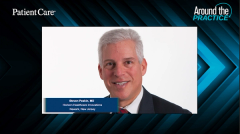
Diabetic Retinopathy Screening Cost of Care and Practice Value
Wade Brosius, DO, and Steven Peskin, MD, review the cost of care and reimbursement schemes available to practitioners completing diabetic retinopathy screenings.
Episodes in this series

Allen Dobson, Jr., MD, FAAFP: I’m particularly interested in how both of you seem to have experience in 1-stop shopping, doing the screening in your office when you’ve got them in front of you. It seems to be a good strategy for at least checking that first box of not missing patients and letting them go unscreened. Can you guys comment on the cost of equipment or software? What’s the marketplace like? I must admit that it’s been a few years since I’ve explored that. It was a new technology a while back, but it sounds like some of the bumps in the road have been worked out, and it’s a plausible and feasible thing for primary care physicians to offer.
Wade Brosius, DO: For us, it has been fantastic. We always try to go after the Quadruple Aim. We’re trying to improve quality, decrease costs, improve patient satisfaction, and help out with provider satisfaction. This is one of those things that checks all 4 of those boxes. The patients love it because you’re able to do it right at your office. The doctors love it because we’re able to get a result very quickly. We’re able to decrease costs because we’re not necessarily spending specialist money all the time. And like I said, in the office, we’ve had a really positive experience, even with the rest of the staff, because they’ve been able to do it so easily.
From a cost perspective, I’d love to hear Shelton’s experience too, but we lease our equipment and we only need 5 for break-even per month. Most providers could probably do 5 per day if they wanted to. From a cost perspective, there’s no doubt that it’d be something that’s revenue positive for any primary care provider that wants to do it. And that’s not counting the money you’re getting from the value-based contract.
Steven Peskin, MD: This is with my clinic hat and not my payer hat. I liked what you said about the medical assistant being able to operate at the top of their license or certification. The fourth part of the Quadruple Aim is health care professional sustainability, bringing joy back into the practice of medicine, nursing, or medical assisting. That’s a good thing as well from the standpoint of the team.
Allen Dobson, Jr., MD, FAAFP: It sounds like one of the big things is trying to overcome the barriers, and it sounds like in-office testing checks a lot of those boxes. Is it signing up for a service, or do you buy the equipment and create a contract? What does that look like these days?
Shelton Hager, MD: We bought the equipment. But then again, we’re coordinating between about 20 family physicians in that central area, so we can usually use it in our diagnostic center as part of the preventative plan for the patients. Toward the end of the year, when we get tight on filling gaps, we also do it in our office space. Even the technology in the equipment is getting better, where it’s becoming more sensitive. The room doesn’t have to be as dark as it once was in order to get a good examination.
Allen Dobson, Jr., MD, FAAFP: When you buy or lease the equipment, does it come with the relationship for the screening overreads?
Shelton Hager, MD: Ours did.
Wade Brosius, DO: Ours does as well. I can’t speak highly enough of the support we’ve had. We originally had a few issues with the handheld. We had great support there. Now that we switched over to the desktop, it takes 2 minutes or less. I completely agree with Shelton that the technology continues to improve. With some of the abnormalities that we’ve recently had, with some of the staff that was well trained originally, they got new people in, and we got a call right away that there were starting to be halos that were happening. We just needed to have retraining of the staff to make sure patients were fully up into the cups by having their chin in the chin rest and their forehead fully up. It was amazing how quickly that happened. It has been an exceptional experience.
Allen Dobson, Jr., MD, FAAFP: Wow, that’s pretty exciting. Usually when we have these new technologies, there’s always uncertainty around reimbursement. Have you found that to be the case? Steven, is that something that you’re seeing in the industry, that it’s standard to be paid for?
Steven Peskin, MD: Yes. This was one that was a low challenge given that we quickly saw what the value is. The value of having screenings increases that and adds economic value and quality to the plan. There have been no issues there. It’s up to the family physicians and internists regarding whether they want to lease it or buy it. They do their own ROI [return on investment] assessment. But as far as the payer paying for it, there are no barriers there from our perspective to get the images accomplished and then the reading done by the retina subspecialist.
Allen Dobson, Jr., MD, FAAFP: Shelton and Wade, do you have any payer issues? Is it pretty universal that the payers will accept and pay for the service?
Wade Brosius, DO: Yes, from my experience, it has been. Although, we did our homework ahead of time and found out what the codes were and ran them by our representatives for each of our larger payers. There was only 1 in question. And within 3 months, they agreed to pay for it as well, so we’ve had no problems whatsoever.
Shelton Hager, MD: We’ve had absolutely no problems. Because it’s 1 of the star quality metrics, the payers want to get it done.
Allen Dobson, Jr., MD, FAAFP: Absolutely. Are most of your reimbursements split, where the primary care office gets the technical fee and the specialist gets the overread? Is that how all of them work?
Shelton Hager, MD: I believe so.
Wade Brosius, DO: It is at our office.
Steven Peskin, MD: That’s the way we do it.
Allen Dobson, Jr., MD, FAAFP: That sounds like a reasonable proposition. But we’ve mentioned the star metrics, and that could be big dollars for the primary care doctor. Closing those and moving those star ratings up is always tied to increased reimbursement. Would you guys agree with that?
Steven Peskin, MD: Yes. Retina screening is in our core measure set, so it’s material. I’m not going to oversell it. It’s 1 measure out of maybe a half-dozen or 8, but it’s material. You’ve got your quality measures and your total costs, and you need to hit both.
Wade Brosius, DO: Yes, that’s how it is for us as well. From my perspective, diabetes as a whole winds up being one of the largest bulk of our quality measures, because generally in our contracts—they’re regional—you get 1 point for retinal screening and 1 point for microalbumin-to-creatinine ratios. Almost all of the other measures are triple weighted. Are they on a statin? Are they on an ACE [angiotensin-converting enzyme] inhibitor or an ARB [angiotensin receptor blockers]? Is their A1C [glycated hemoglobin] less than 9%? Do they have medication adherence for the medications they need to be on? If you focus on diabetes and do that whole thing well, you’re going to be very successful in your value-based contracts.
Shelton Hager, MD: And provide good care.
Transcript Edited for Clarity
Newsletter
Enhance your clinical practice with the Patient Care newsletter, offering the latest evidence-based guidelines, diagnostic insights, and treatment strategies for primary care physicians.





































































































































































































































































































































